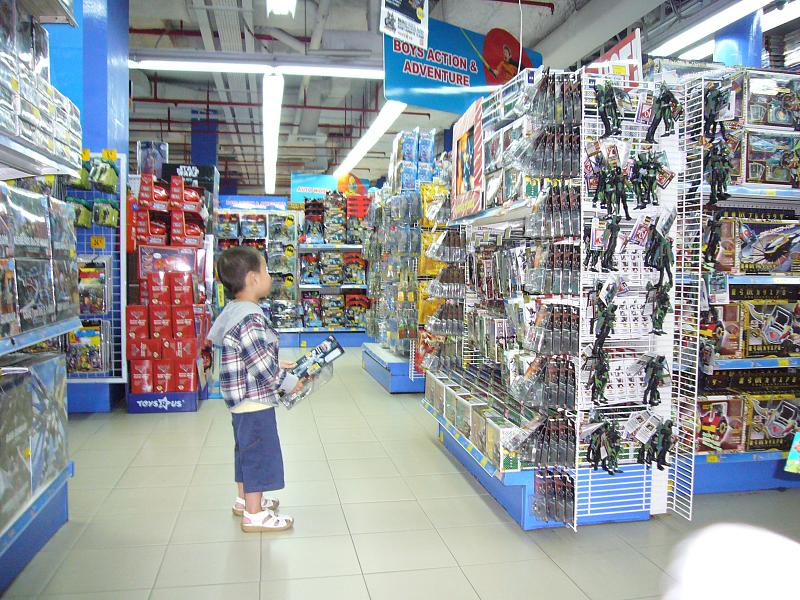
Toys R’Us and Power Rangers – a potent kid marketing combination!
As the father of a five-and-a-half year old boy, I naturally have a deep interest in what goes into that little cranium of his.
Why is my son attracted to certain brands and products more so than others? What made his tastes in toys so different from his cousin who is merely 5 years older than him?
I found the answers to these and more in the book “What Kids Buy and Why – The Psychology of Marketing to Kids” by Daniel S. Acuff, a marketing consultant with a PhD in Education.
According to Acuff, kids go through critical neurological and sociological changes as they grow and mature. Significant differences also exist between boys and girls.
Collectively, these differences exert a significant impact on their buying behaviours.
Product Leverage Matrix
To understand the world of kids, the book proposed that we use a Product Leverage Matrix to analyse and sort out all aspects of a product or programme and how kids would relate to it.
This would cover the following variables:
- Consumer Characteristics (age, gender, stage, structure, dimension, style)
- Past Experience with the product/programme
- Concept, ie the core idea of the product/programme
- P.O.V. (point of view) which examined the psychological or philosophical orientation (like values) of a product or programme
- Content which is both verbal and visual in nature
- Context, ie the environmental and social setting of a specific product or programme
- Process, which mapped out how an item engages and interacts with a kid at different touchpoints, as well as usability factors and the deployment of multi-sensorial technologies
- Characters/Personality which examined how icons and “larger-than-life” icons like Mickey Mouse, Power Rangers and even Michael Jordan (or Yao Ming) influence the tastes of kids
- Attitude/Style which looked at the brand personality of the product or service, eg cool and hip, authentic, rebellious, futuristic and so on
Other than these factors, various other product characteristics like its Essence, Point of Difference (commonly labelled as USP or Unique Selling Proposition by marketers), Assumed Leverage versus Actual Leverage, Promise, Competition and Positioning were cited as important considerations.
These aspects probably relate closely to the brand positioning of a child-oriented product or programme, and its degree of remarkability vis a vis other competing brands.
Stages of Childhood and Adolescence
In Acuff’s world, the path of childhood and adolescence is divided into the following phases:
Birth through Age 2
Also known as the Dependency/Exploratory Stage, toddlers and babies are highly dependent on their parents (particularly mothers) for their purchases. Their neurological make-up is largely reflexive and instinctive, and kids of this age usually do not have a sense of morality. Bright, colourful and simple concepts probably work best here.
Ages 3 Through 7
Also known as the Emerging-Autonomy Stage, children of this age show significant developments in their brain development, especially the imaginative “Right brain” as well as that controlling emotions.
Kids of this age are largely self-centred and independent although some semblance of socialisation may occur. They also love to accumulate stuff (eg my son’s fetish for collecting seashells or ruby-red saga seeds!), and fantasy abounds.
Winning brands include the Disney characters like Mickey Mouse and Donald Duck, Power Rangers and Warner Brothers’ Looney Tunes.
Ages 8 Through 12
Also known as the Rule/Role Stage, kids transitioning into this phase (Tweens) start to look at real life role models more than fantasy characters. Their intellectual and logical “left brain” starts developing more profusely and this makes them more interested in intellectually stimulating toys and play activities.
Pushing away from “childish” brands, they are avid watchers of television and are significantly more group-oriented than their younger counterparts.
Winning brands include Mattel’s Barbie, GI Joe, and the tonnes of electronic and computer games available.
Ages 13 Through 15
Also known as Early Adolescence, the onset of puberty brings about significant changes in how teenagers purchase.
Teens have a greater need for a stronger self-esteem as they establish their own identities, and their growing sexuality also influence purchase decisions. They are also a lot more sophisticated and social than younger kids, and are avid consumers of magazines, the internet and pop or mainstream culture.
Interest in sports (and skateboards, Frisbees, rollerblades) start to peak at this age, together with music and more sophisticated games like chess, Monopoly or Risk.
Ages 16 Through 19
The period of Late Adolescence represent the end of childhood as a youth emerges to become an adult.
A major neurological change appears with the completion of the prefrontal lobe of the brain, which looks after the “executive function” of the brain. These covers areas such as how a teen thinks about thinking, empathy, sophisticated problem solving, and the increased “space” between stimulus and response.
Most hormonal changes would have been completed by now. Peer pressure is probably at its peak during this age.
Winning products include magazines like Seventeen and Rolling Stone, MTV, and sport heroes like Michael Jordan or actors like Ashton Kutcher (the guy with more than a million Twitter followers).
Importance of Characters – Fantastic and Real
One important point about marketing to kids is the emphasis on characters both fantastic and real – from Barney the Dinosaur to Mickey Mouse, Spiderman, Harry Potter (or Daniel Radcliffe), Britney Spears, Michael Jackson (RIP) to the Simpsons – these personalities play a vital role in their relationship to the young.
By developing distinctive mascots with their own unique quirks, marketers are better able to capture the share of youth wallets (or that of their longsuffering parents).

very nice read!
Angel Morales
marketinginfantil.com